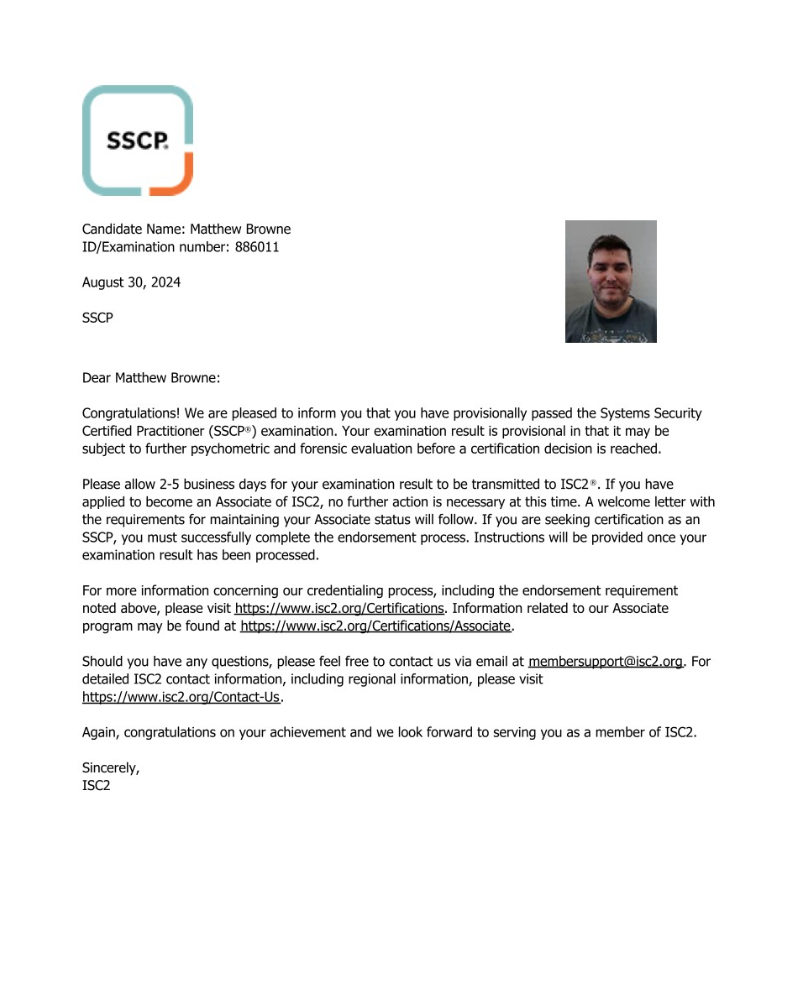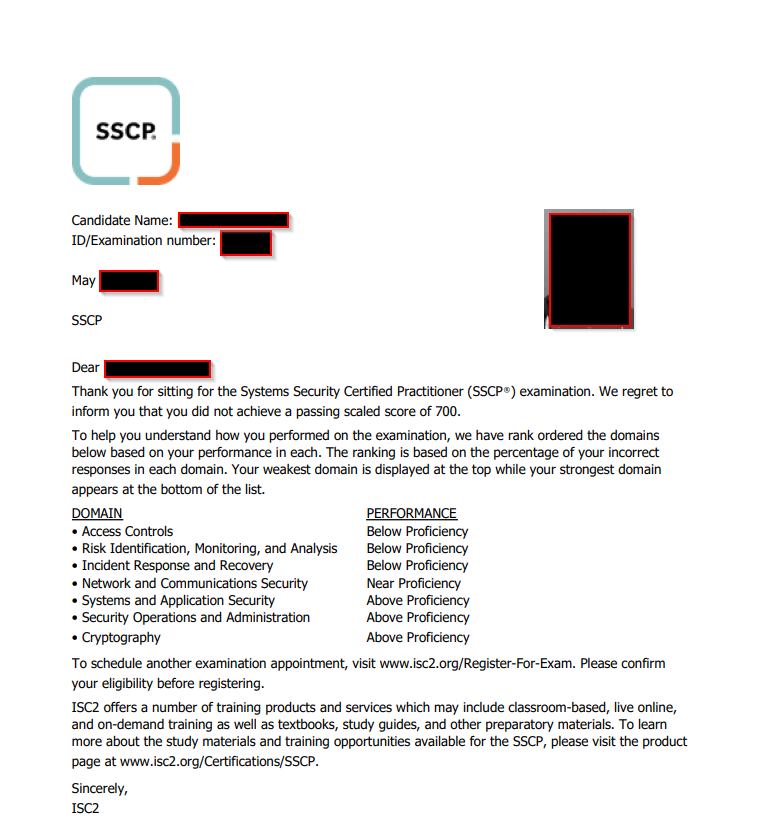
The Systems Security Certified Practitioner (SSCP) exam, administered by (ISC)², is a globally recognized certification that validates an individual’s knowledge and skills in information security. The SSCP is designed for IT professionals who are responsible for implementing and managing security policies and procedures within their organizations.
This review will cover various aspects of the exam, including its structure, preparation strategies, and overall experience.
Exam Structure and Content
The SSCP exam consisted of 150 multiple-choice questions of which 25 are test questions these must be completed within a four-hour time frame. The questions are based on seven domains outlined in the (ISC)² Common Body of Knowledge (CBK), which includes:
- Security Operations and Administration 16%
- Access Controls 15%
- Risk Identification, Monitoring and Analysis 15%
- Incident Response and Recovery 14%
- Cryptography 9%
- Network and Communications Security 16%
- Systems and Application Security 15%
Each domain has a specific weight in terms of the number of questions, reflecting its importance in the field of information security.
The Systems Security Certified Practitioner (SSCP) exam is structured to evaluate candidates on their knowledge and skills across seven distinct domains of cybersecurity. Each domain encompasses specific topics that are critical for professionals working in operational security roles.
Preparation for the Exam
Preparing for the SSCP exam requires a structured approach due to the breadth of topics covered. Here are some effective strategies which I used in my preparation.
My best advice is to utilize official study guides published by (ISC)² as well as supplementary resources such as textbooks focused on each domain. Online courses can also provide valuable insights alongside YouTube and LinkedIn learning.
Taking practice exams is crucial for familiarizing yourself with the question format and timing constraints. Many online platforms offer practice tests that simulate the actual exam environment.
Joining a study group or forum can enhance your understanding through discussions with peers who are also preparing for the exam.
Practical experience in information security roles can significantly aid in understanding theoretical concepts better really and truly you’re going to want to have at least 2 years in a security analyst , security consultant of Cybersecurity Architect role.
Regularly revisiting key concepts and domains helps reinforce knowledge retention leading up to the exam date Tip the day before the exam test yourself on knowledge and run through a practice exam to confirm your level of understanding across all 7 domains.
Exam Experience
On exam day, candidates should arrive early to allow time for check-in procedures , I scheduled my exam for 11 o’clock but arrived at 09:30 , I filled out the form provided my two forms of identification , had both my picture taken and a palm and vein scan as ISC2 are very secure. I was then brough up to my testing station where I had 2 minutes to accept the NDA , failure to complete this within the time frame will result in loss of exam so my advise is to do this first.
When taking the exam I needed to remember a few things
• Read each question carefully before answering. ( don’t rush through them )
• Manage your time effectively; if unsure about a question provided a best guess.
• Remember to use educated guesses when necessary , eliminate clearly wrong answers to improve your chances of answering correctly.
For my exam I was brought straight up to all 150 questions , when I submitted it said my exam ended and go down and do the walk to collect your belongings from your locker this adds an element of excitement but also pressure for the candidate the proctor then hands you a report which states Pass or Fail.
It will Look something like this if you Pass
 Or it will look something like this if you Fail
Or it will look something like this if you Fail

The fail report will provide you a indicator in terms of how you failed if you failed to re-study specific domains , if you pass you will receive a congratulation’s report.
Once this is complete the next thing you need to do is go through the endorsement Process , ISC2 will send you an email which looks something like this to continue onto the next stage.
Link for endorsement can be found on the ISC2 Website : https://www.isc2.org/
Once you complete the endorsement Progress ISC2 will send you an email which looks similar to this
You can check your status at any time it will look something like this
What this means is its been reviewed by your Endorser and is Awaiting review from ISC2 , this may take 4-6 weeks.
If your application is under review you may get an error if you have not provided enough information it may look like this , to resolve this you must reply back to ISC2 with the required information you will probably get an email that looks similar to this :
So once your application is submitted and has been accepted by ISC2 it may look like the below. also check your email for an automated message which will look like this :
for anyone That is going through the process this is your last step before you make your AMF Payment
Once you make your AMF payment on the ISC2 website you will then see on the bottom left your option to print your Certificate within your account , Once everything has been paid up you will also get notified by Credily with a Congratulation’s email.
Link to AMF : Info https://www.isc2.org/policies-procedures/amfs-overview
Your certificate will look something like this :
Do not forget you should also get a physical pack as well in the post.
Post-Exam Reflection
Upon passing the SSCP exam, candidates earn recognition as certified practitioners capable of contributing significantly to their organizations’ security posture.
The certification not only enhances career prospects but also instills confidence in one’s ability to handle real-world security challenges.
Looking back I can honestly say for me this was a learning curve i never realised how difficult ISC2 exams were until I sat for this one while there are higher exams with ISC2 this is a very worthwhile exam to take to get yourself immersed in there content and exam taking skills , also it feels pretty good to build another learning journey with ISC2.
The Welcome Kit
As a ISC2 SSCP Holder you will receive a Physical Kit in the post , as soon as I have mine ill update this blog post with pictures and video’s.
You will also be able to download your Certificate from Your member profile and you will also receive a digital badge from Credily , They will look something like this , (As soon as I have these ill add them to my blog post)
Conclusion
In summary taking the SSCP – Systems Security Certified Practitioner ISC2 Exam is a rigorous yet rewarding process that requires thorough preparation and practical application of knowledge in information security principles my best advice is to study hard , utilise multiple resources , LinkedIn learning is your friend , YouTube provides some great content from well respected individuals within the industry , remember its a journey so enjoy it weather you pass or fail.
More Info below on ISC2 Website
https://www.isc2.org/certifications/sscp